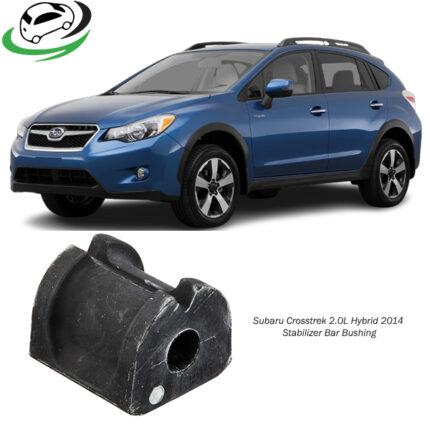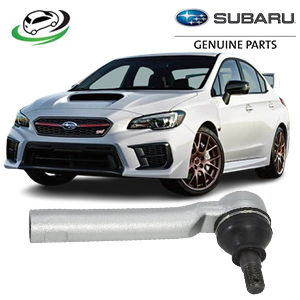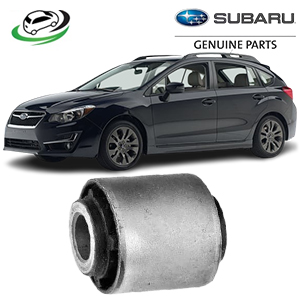-10%
Get Subaru Impreza 2015 Suspension Control Arm Bushing 20254FG020
The suspension control arm bushing is a vital component of a vehicle’s suspension system, playing a crucial role in maintaining proper alignment, improving ride quality, and ensuring vehicle handling. In this detailed overview, we will explore the functions, benefits, structure, signs of wear, and maintenance tips related to control arm bushings.
1. What is a Suspension Control Arm Bushing?
A suspension control arm bushing is a rubber or polyurethane component that connects the control arm to the vehicle’s frame or chassis. Control arms are essential parts of the suspension system, allowing for vertical movement of the wheels while maintaining proper alignment. The bushings provide a cushion between the control arm and the chassis, allowing controlled movement while reducing noise and vibrations.
Structure and Composition
- Control Arm: A metal arm that connects the wheel hub to the vehicle’s frame, allowing the wheel to move up and down while keeping the alignment correct.
- Bushings: Typically made from rubber or polyurethane, these cylindrical components surround the control arm’s pivot points and connect it to the chassis.
- Mounting Brackets: These metal brackets secure the bushings and control arms in place, bolting them to the vehicle’s frame.
2. Functions of a Suspension Control Arm Bushing
The primary functions of control arm bushings contribute significantly to the vehicle’s suspension performance and overall driving experience.
a. Allowing Controlled Movement
Control arm bushings permit the control arms to pivot and move vertically, allowing for the up-and-down motion of the wheels. This movement is essential for absorbing bumps and uneven road surfaces while maintaining proper tire contact with the ground.
b. Reducing Noise and Vibrations
Bushings act as cushions that isolate road vibrations and noise from being transmitted through the control arms to the vehicle chassis. This isolation improves ride comfort and contributes to a quieter cabin environment.
c. Providing Alignment and Stability
By securely connecting the control arm to the chassis, the bushings help maintain the correct wheel alignment and positioning. Proper alignment is critical for effective steering, tire wear, and overall vehicle stability.
d. Absorbing Shock Loads
When the vehicle encounters bumps or obstacles, the control arm bushings absorb shock loads, protecting the suspension components and preventing damage to the vehicle’s frame.
e. Supporting Suspension Geometry
Control arm bushings help maintain the proper geometry of the suspension system, ensuring that the vehicle handles well during cornering and that tire wear is minimized.
3. Benefits of Properly Functioning Suspension Control Arm Bushings
When suspension control arm bushings are in good condition, they provide several benefits that enhance the driving experience and improve vehicle performance.
a. Improved Ride Quality
Well-functioning control arm bushings contribute to a smoother ride by effectively absorbing road shocks and minimizing vibrations. This results in increased comfort for both the driver and passengers.
b. Enhanced Handling and Stability
Control arm bushings play a crucial role in maintaining proper wheel alignment, which is essential for vehicle handling. Good bushings help ensure that the suspension system works as designed, resulting in improved steering response and stability during turns.
c. Reduced Tire Wear
Properly functioning bushings help maintain the correct alignment of the wheels, reducing uneven tire wear. This leads to longer tire life and less frequent replacements.
d. Increased Longevity of Suspension Components
By cushioning the movements of the control arms and absorbing shock loads, bushings reduce wear and tear on other suspension components. This increases the overall lifespan of the suspension system.
e. Better Safety
When control arm bushings are in good condition, they contribute to the overall safety of the vehicle by ensuring stable handling and effective braking. Worn bushings can compromise control, leading to potential hazards on the road.
4. Signs of a Failing Suspension Control Arm Bushing
Like any vehicle component, control arm bushings can wear out over time, especially with exposure to harsh driving conditions and road debris. Here are common signs that the bushings may be failing:
a. Clunking or Rattling Noises
One of the most noticeable signs of worn control arm bushings is clunking or rattling noises, particularly when driving over bumps or rough roads. This noise indicates that the bushings have deteriorated and the control arm is no longer securely attached to the chassis.
b. Poor Handling and Steering Response
If you notice that the vehicle feels loose or unstable, especially during cornering or sudden lane changes, this may indicate that the control arm bushings are worn. A decrease in steering response can also be a sign of bushing failure.
c. Uneven Tire Wear
Worn control arm bushings can lead to misalignment, causing uneven tire wear. If you notice that your tires are wearing down more on one side than the other, it may be time to inspect the bushings.
d. Vibration or Harsh Ride
Excessive vibrations while driving, particularly over bumps or uneven surfaces, can indicate that the control arm bushings are failing to absorb shocks effectively. This can lead to a harsh and uncomfortable ride.
e. Visible Damage
If you can see visible cracks, tears, or deformities in the rubber or polyurethane bushings, it’s a clear indication that they need to be replaced.
5. Maintenance of Suspension Control Arm Bushings
Regular maintenance and timely replacement of control arm bushings are essential for ensuring vehicle performance and safety. Here are several key tips for maintaining these components:
a. Routine Inspections
Include control arm bushings in regular vehicle inspections. Look for signs of wear, such as cracks, tears, or excessive play in the bushings. If any issues are detected, replacement is necessary.
b. Monitor for Noises and Poor Handling
Stay attuned to any unusual noises or changes in handling characteristics. If you notice clunking, rattling, or decreased steering response, have the bushings inspected immediately.
c. Lubrication (if Applicable)
Some control arm bushings, particularly those made from polyurethane, may require periodic lubrication to prevent squeaking and reduce friction. Follow the manufacturer’s recommendations for lubrication intervals and products.
d. Replace Worn Bushings Promptly
If the control arm bushings are worn or damaged, replace them as soon as possible. Driving with worn bushings can lead to further damage to the suspension system and affect overall safety and handling.
e. Keep Bushings Clean
Keeping the bushings clean from dirt, road grime, and moisture helps prevent premature wear. Regular cleaning with mild soap and water, followed by thorough drying, can prolong their lifespan.
6. Steps to Replace Suspension Control Arm Bushings
Replacing suspension control arm bushings is a manageable task that can typically be accomplished with basic tools. Here’s a general guide on how to replace them:
1. Gather the Necessary Tools
You’ll need basic tools such as a socket set, wrench, jack, jack stands, and the replacement bushings. Some bushings may require lubricant for installation.
2. Raise the Vehicle
Use a jack to lift the vehicle and secure it on jack stands. This will provide access to the control arms and bushings.
3. Locate the Control Arm and Bushings
Identify the control arm, which connects the wheel hub to the chassis. The bushings are typically located at the pivot points of the control arm.
4. Remove the Control Arm
To replace the bushings, you may need to remove the control arm. Use a socket or wrench to remove the bolts securing the control arm to the chassis and the steering knuckle.
5. Remove the Old Bushings
Slide the old bushings out of the control arm. If they are cracked, torn, or deformed, they will need to be replaced.
6. Install the New Bushings
Press the new bushings into the control arm in the same orientation as the old ones. Make sure the bushings are properly aligned and seated.
7. Reattach the Control Arm
Reinstall the control arm by bolting it back to the chassis and steering knuckle. Ensure that all bolts are tightened to the manufacturer’s specifications.
8. Lower the Vehicle
Once the new bushings are installed and the control arm is secure, carefully lower the vehicle.
9. Test Drive the Vehicle
After replacing the bushings, take the vehicle for a test drive to ensure that clunking noises have disappeared and that handling has improved.
Conclusion
Suspension control arm bushings are crucial components that significantly impact a vehicle’s handling, stability, and ride quality. By allowing controlled movement, reducing noise and vibrations, and supporting proper alignment, control arm bushings play a key role in ensuring a smooth and safe driving experience. Regular inspection, maintenance, and timely replacement of worn bushings will help ensure that your vehicle continues to perform optimally on the road, providing comfort and safety for you and your passengers.
Follow us on Facebook for more parts.




Reviews
Clear filtersThere are no reviews yet.